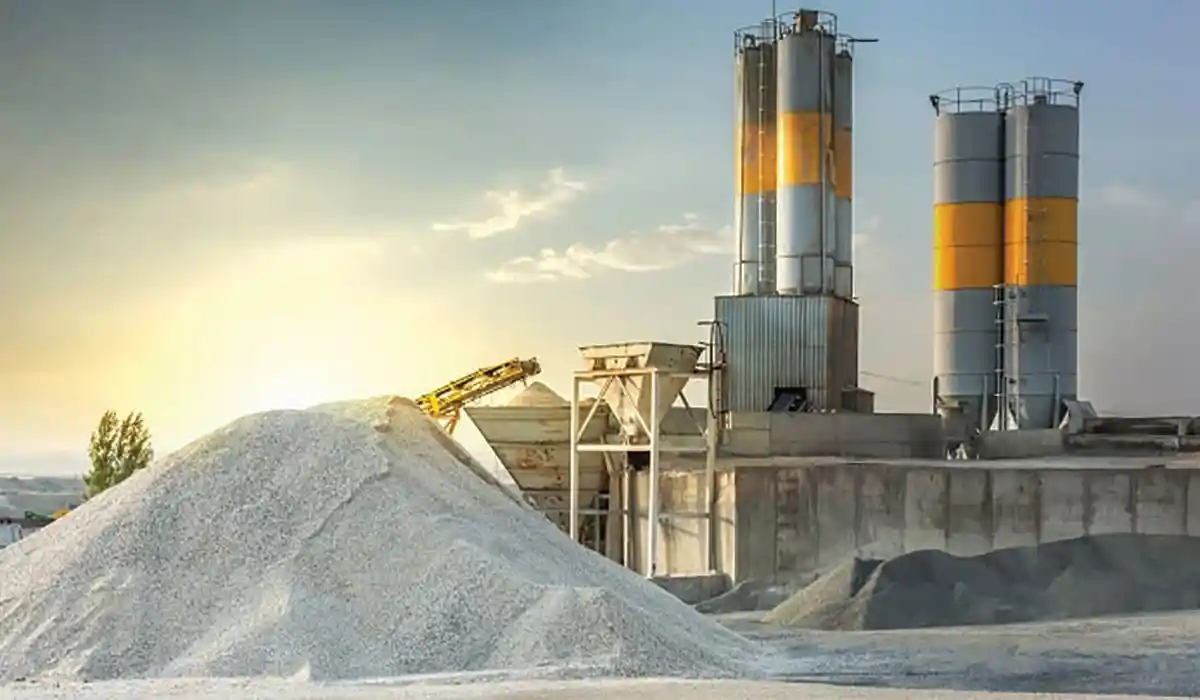Carbon Neutrality in Cement Industry A Global Perspective
Increasing energy costs, overcapacity, and environmental pollution are the top concerns of the cement industry, which is one of the major contributors to CO2 emissions.
Dr S B Hegde, Professor, Department of Civil Engineering, Jain College of Engineering & Technology & Visiting Professor, Pennsylvania State University, United States of America, and Dr. Prashanth Banakar, Principal, Jain College of Engineering & Technology, Hubballi, Karnataka

As per the first report from WEF’s Net-Zero Industry Tracker 2022, to enable low-emission cement plants, it is predicted that cement consumption will increase by 46% by the year 2050, necessitating an investment of US$185 billion in clean hydrogen production and infrastructure for CO2 handling.
With 6 to 9% of the world’s CO2 emissions coming from cement, it is one of the major contributors to climate change. In order to significantly minimise this, the cement industry will eventually see a decrease in cement volumes as well as a shift towards pre-fabrication and developing new manufacturing methods.
Three key strategies - optimize, electrify, and decarbonize - can enable nations to satisfy their energy needs while emitting zero carbon dioxide. Basically, all nations must reduce energy usage through increased efficiency (optimise); and shift energy demand to electricity and away from fossil fuel burning (electrify).
It is expected that globally, the middle-class will have a 100% more purchasing power by 2050. There would be tremendous repercussions for global industries that produce basic materials and energy to sustain modern society from housing to consumer goods. The most significant contributor’s anthropogenic CO2 emissions today are from these industries. Demand for energy and industrial products is projected to grow by 30-80% by 2050. In order to achieve climate goals, we need to decarbonize the processes and value chain of industries.
The actuality of net-zero for these businesses is trailing, despite ongoing efforts and commitments, and extrapolating from the current rate of advancement, will fall well short. To address an underserved area of the transition, it is essential to bring increased transparency into the reality of the current gap and raise discussions on how to structurally solve the problem. While it is heartening to see sustainability indicators being adopted and monitored at the national level in carbon-intensive industries like building construction, transportation, and power production, heavy industries still have a long way to go.
In carbon-intensive sectors such as power generation, construction, and transportation, standardization and monitoring of sustainability metrics are encouraging, but there are significant gaps in heavy industries.
The World Economic Forum has benchmarked countries’ energy transition through the Energy Transition Index for ten years. Now is the time for industries and governments to increase their efforts to decarbonize industrial processes, improve energy efficiency, and reduce their dependence on fossil fuels. Governments and industries should double down on efforts to accelerate decarbonization, improve energy efficiency, and reduce fossil fuel dependence.
Carbon neutrality in global cement industries
The manufacturing process of cement generates two sources of greenhouse gases: 40% of them come from burning fossil fuels to heat kilns at 1300-1450°C; while 60% come from the thermal decomposition of limestone into carbon dioxide and lime, both of which are essential components of cement (about 70%).
Cement industry, with 6% of all man-made emissions, is the second largest emitter, after steel. Societal needs and urbanization are expected to increase cement demand by 45% by 2050. As part of the Net-Zero 2050 pathway proposed by the IEA, the increase should be limited to current levels.
The cement industry can already reduce emissions without introducing disruptive technologies by leveraging efficiency and circularity levers like lowering the clinker-to-cement ratio and utilising waste from other industries as alternative fuels. The only known method for bringing sectoral emissions close to zero is by using CCUS technology; whose use could result in a 50–85% rise in production costs. By 2030, the technology is anticipated to be at the commercial level.
In addition to investments in carbon capture on industrial assets, at least $185 billion is required to create the infrastructure for low-emission power and hydrogen production, as well as the transport and storage of 1,370 MTPA of CO2 (the second-largest need in the IEA Net Zero scenario by 2050).
Low-carbon cement is anticipated to enter the market with a green premium above 50% due to the high cost of carbon capture, which would result in 1-3% rise in housing costs. The cement consumers’ demand signals for low-emission cement are essential for motivating investments. To do this, cement buyers’ confidence in their capacity to transfer the premium onto the final consumers must be strengthened.
For first movers in the low-emission cement sector, greater international collaborations and stronger regulatory measures, such as carbon pricing, carbon border adjustment mechanisms, circularity, or product specification standards, can help develop a competitive and financially sustainable market. By 2050, the sector will need to invest $500 billion in carbon capture technologies, or $16 billion annually, on top of current investments. A sufficient taxonomy and substantial governmental finance assistance will make it easier to get green bonds, which will help businesses.
Measures for achieving net zero emission
We reiterate the following actions on an immediate basis:
There is a lot of work to accomplish. “Low-emission” industries need to be defined by international standards.
Technologies for low-carbon production must prove their worth on a large scale. In order to create demand for low emission products, consumer acceptability and awareness must advance. Infrastructures must be built in order to create and integrate low-carbon processes.
Markets with minimal carbon emissions must become economically viable. To hasten capital inflows, investments must be “de-risked.” A strong policy foundation can encourage and facilitate change.
Governments and industries should double down on efforts to accelerate decarbonization, improve energy efficiency, and reduce fossil fuel dependence.
Without a paradigm shift in multistakeholder collaboration across vast industrial ecosystems, these and other goals cannot be accomplished. They cannot both be attained if equity and justice are not prioritised during industry transitions. It is essential to people’s livelihoods and possibilities.
One of the most difficult obstacles to overcome in the energy transition may be industrial decarbonization. But we want to be upbeat. There are established industry routes to net-zero, and transparency is growing. If the global aspiration and spirit of cooperation displayed at COP26 and the World Economic Forum Annual Meeting in 2022 in Davos spur effective action, we might observe this decade as one of the key turning points for net-zero sectors.
About the Authors
 Dr S B Hegde is currently a ‘Professor’ at the Department of Civil Engineering, Jain College of Engineering and Technology, Hubli, Karnataka and also a ‘Visiting Professor’ of Pennsylvania State University, United States of America. He has more than 30 years of experience in Cement Manufacturing and has held leadership positions in reputed cement companies in India and overseas. He is also a recipient of the ‘Global Visionary Award’ in 2020.
Dr S B Hegde is currently a ‘Professor’ at the Department of Civil Engineering, Jain College of Engineering and Technology, Hubli, Karnataka and also a ‘Visiting Professor’ of Pennsylvania State University, United States of America. He has more than 30 years of experience in Cement Manufacturing and has held leadership positions in reputed cement companies in India and overseas. He is also a recipient of the ‘Global Visionary Award’ in 2020.
 Dr. Prashanth Banakar is presently serving as an Academic Council member, Davangere University, and Principal at Jain College of Engineering & Technology Hubballi. He has more than 17 years of academic experience and is presently guiding many Ph.D. scholars, and is doing research on Materials, Polymer Composites, Finite Element Methods, and Rapid Prototyping. Under his leadership, Jain College has been enlisted by the Government of Karnataka in the Super 30 program for the RETE to build model engineering colleges in the state.
Dr. Prashanth Banakar is presently serving as an Academic Council member, Davangere University, and Principal at Jain College of Engineering & Technology Hubballi. He has more than 17 years of academic experience and is presently guiding many Ph.D. scholars, and is doing research on Materials, Polymer Composites, Finite Element Methods, and Rapid Prototyping. Under his leadership, Jain College has been enlisted by the Government of Karnataka in the Super 30 program for the RETE to build model engineering colleges in the state.
Dr S B Hegde, Professor, Department of Civil Engineering, Jain College of Engineering & Technology & Visiting Professor, Pennsylvania State University, United States of America, and Dr. Prashanth Banakar, Principal, Jain College of Engineering & Technology, Hubballi, Karnataka

As per the first report from WEF’s Net-Zero Industry Tracker 2022, to enable low-emission cement plants, it is predicted that cement consumption will increase by 46% by the year 2050, necessitating an investment of US$185 billion in clean hydrogen production and infrastructure for CO2 handling.
With 6 to 9% of the world’s CO2 emissions coming from cement, it is one of the major contributors to climate change. In order to significantly minimise this, the cement industry will eventually see a decrease in cement volumes as well as a shift towards pre-fabrication and developing new manufacturing methods.
Three key strategies - optimize, electrify, and decarbonize - can enable nations to satisfy their energy needs while emitting zero carbon dioxide. Basically, all nations must reduce energy usage through increased efficiency (optimise); and shift energy demand to electricity and away from fossil fuel burning (electrify).
It is expected that globally, the middle-class will have a 100% more purchasing power by 2050. There would be tremendous repercussions for global industries that produce basic materials and energy to sustain modern society from housing to consumer goods. The most significant contributor’s anthropogenic CO2 emissions today are from these industries. Demand for energy and industrial products is projected to grow by 30-80% by 2050. In order to achieve climate goals, we need to decarbonize the processes and value chain of industries.
The actuality of net-zero for these businesses is trailing, despite ongoing efforts and commitments, and extrapolating from the current rate of advancement, will fall well short. To address an underserved area of the transition, it is essential to bring increased transparency into the reality of the current gap and raise discussions on how to structurally solve the problem. While it is heartening to see sustainability indicators being adopted and monitored at the national level in carbon-intensive industries like building construction, transportation, and power production, heavy industries still have a long way to go.
In carbon-intensive sectors such as power generation, construction, and transportation, standardization and monitoring of sustainability metrics are encouraging, but there are significant gaps in heavy industries.
The World Economic Forum has benchmarked countries’ energy transition through the Energy Transition Index for ten years. Now is the time for industries and governments to increase their efforts to decarbonize industrial processes, improve energy efficiency, and reduce their dependence on fossil fuels. Governments and industries should double down on efforts to accelerate decarbonization, improve energy efficiency, and reduce fossil fuel dependence.
Carbon neutrality in global cement industries
The manufacturing process of cement generates two sources of greenhouse gases: 40% of them come from burning fossil fuels to heat kilns at 1300-1450°C; while 60% come from the thermal decomposition of limestone into carbon dioxide and lime, both of which are essential components of cement (about 70%).
Cement industry, with 6% of all man-made emissions, is the second largest emitter, after steel. Societal needs and urbanization are expected to increase cement demand by 45% by 2050. As part of the Net-Zero 2050 pathway proposed by the IEA, the increase should be limited to current levels.
The cement industry can already reduce emissions without introducing disruptive technologies by leveraging efficiency and circularity levers like lowering the clinker-to-cement ratio and utilising waste from other industries as alternative fuels. The only known method for bringing sectoral emissions close to zero is by using CCUS technology; whose use could result in a 50–85% rise in production costs. By 2030, the technology is anticipated to be at the commercial level.
In addition to investments in carbon capture on industrial assets, at least $185 billion is required to create the infrastructure for low-emission power and hydrogen production, as well as the transport and storage of 1,370 MTPA of CO2 (the second-largest need in the IEA Net Zero scenario by 2050).
Low-carbon cement is anticipated to enter the market with a green premium above 50% due to the high cost of carbon capture, which would result in 1-3% rise in housing costs. The cement consumers’ demand signals for low-emission cement are essential for motivating investments. To do this, cement buyers’ confidence in their capacity to transfer the premium onto the final consumers must be strengthened.
For first movers in the low-emission cement sector, greater international collaborations and stronger regulatory measures, such as carbon pricing, carbon border adjustment mechanisms, circularity, or product specification standards, can help develop a competitive and financially sustainable market. By 2050, the sector will need to invest $500 billion in carbon capture technologies, or $16 billion annually, on top of current investments. A sufficient taxonomy and substantial governmental finance assistance will make it easier to get green bonds, which will help businesses.
Measures for achieving net zero emission
We reiterate the following actions on an immediate basis:
- Introduce efficiency measures to promote recycling of concrete and maximise emission reduction in current operations.
- Increase the number of carbon capture initiatives to quicken the technology’s learning curve, lower costs, and advance commercial readiness.
- Create the infrastructure needed for CO2 transit and storage to enable the production of low-emission cement.
- Increase the number of low-emission cement demand signals to encourage investors and manufacturers to invest money in low-emission assets.
- Create policies to support the afore-mentioned four targets and bolster the commercial viability of producing low-carbon cement.
- Electrification with storage. Renewable energy has helped dramatically reduce the carbon intensity of electricity across the globe.
- Waste heat recovery.
- Greengas and biomass.
- Hybrid heating.
- Hydrogen.
- CCUS.
There is a lot of work to accomplish. “Low-emission” industries need to be defined by international standards.
Technologies for low-carbon production must prove their worth on a large scale. In order to create demand for low emission products, consumer acceptability and awareness must advance. Infrastructures must be built in order to create and integrate low-carbon processes.
Markets with minimal carbon emissions must become economically viable. To hasten capital inflows, investments must be “de-risked.” A strong policy foundation can encourage and facilitate change.
Governments and industries should double down on efforts to accelerate decarbonization, improve energy efficiency, and reduce fossil fuel dependence.
Without a paradigm shift in multistakeholder collaboration across vast industrial ecosystems, these and other goals cannot be accomplished. They cannot both be attained if equity and justice are not prioritised during industry transitions. It is essential to people’s livelihoods and possibilities.
One of the most difficult obstacles to overcome in the energy transition may be industrial decarbonization. But we want to be upbeat. There are established industry routes to net-zero, and transparency is growing. If the global aspiration and spirit of cooperation displayed at COP26 and the World Economic Forum Annual Meeting in 2022 in Davos spur effective action, we might observe this decade as one of the key turning points for net-zero sectors.
About the Authors


International Concrete Construction Technology Jan - Feb 2023
















